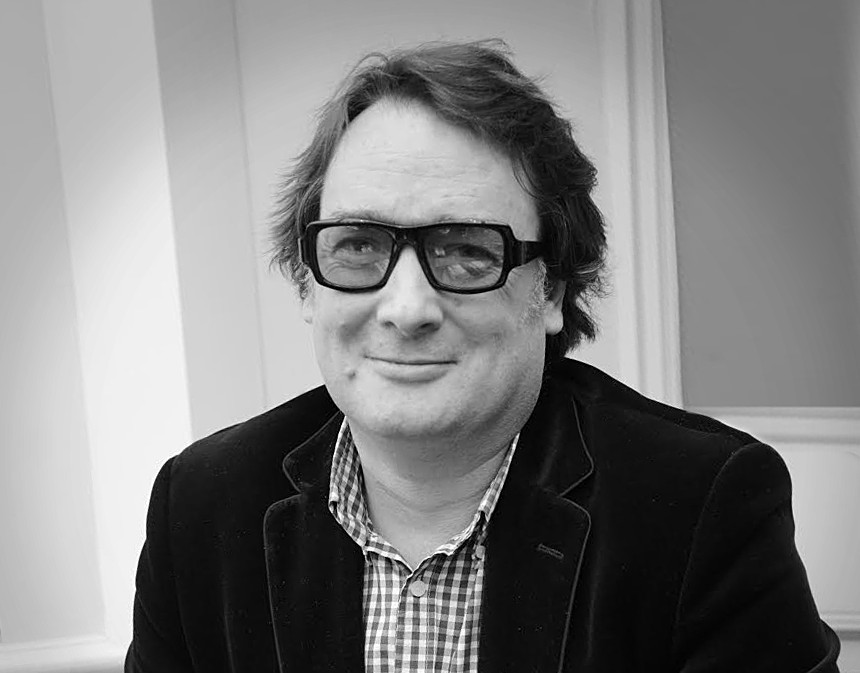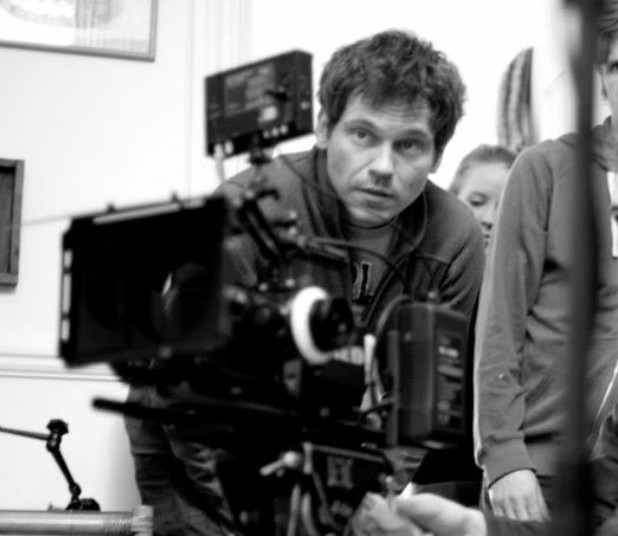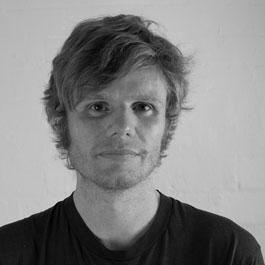Three filmmakers reflect on their experiences in design and filmmaking.

David Chaudoir
In the late nineties, Aaron Trinder, and Marc Hardman and myself, David Chaudoir, all worked at a specialist design agency, English & Pockett, creating identities for television channels, and all of us have gravitated towards writing and directing our own films unbeknownst to each other. When vice in Soho meant nefarious goings-on and not a trendy media outlet, the agency was situated on Bridle Lane, one of the seediest haunts in the square mile: a narrow street, notorious for prostitutes and crack smokers lurking in the wee small hours.
Before After Effects democratised post production, the studio often had the luxury of shooting sequences on 35mm film and post production budgets that would make the Canon 5D and Premiere generation weep with envy. That was “back in the days,” and those days are long gone, along with the money. All three of us continue to work in design, but the lure of film is strong. Aaron Trinder, a musician, designer, writer and director, shot the apocalyptic short Mr Tourquay’s Holiday in 2014 with money from London Calling. Marc Hardman, a stand-up comedian, writer and director, last year directed Myriam Margoles in the short Mother, also soon to be released, whilst I have just completed the short horror film Bad Acid.
In the Autumn of 2015 Trinder and I found ourselves freelancing at the same ad agency. Having not been in touch with each other for over fifteen years, we discovered that ours and our colleague Hardman’s focus was zeroing in on filmmaking.
What drove us three designers toward narrative filmmaking? Has our background in branding helped or hindered our nascent careers, and is there a difference between adjusting the kerning of a font and getting a good performance from an actor? I spoke with Aaron and Marc to find out.
I switched courses from the Fine Art Film degree at St Martins to Audio Visual Graphics, because I had seen a couple of past graduates who were jobless and broke. How did you get into design?
AT: It was basically an accident! I did a drama and film degree so I have no official design training and don’t think of myself as a designer. I was always playing around with moving image, as well as being a musician and DJ for many years. I was doing projection work for theatre companies and then got a job at a publisher where I learned photoshop. As soon as I got myself a Mac I realised you could do all this other moving image stuff. I had no idea what a Television Ident was until I got my first job!
MH: I pretty much stumbled into design. I had studied film production at university and started working as a runner in Soho. I ended up landing a job running for a broadcast design agency and before I left I was working as a junior designer.
What design work may people have seen that you created?
AT: I’ve worked on many major broadcasters redesigns - BBC news, ITV 3, ITV news e.g.
MH: I once designed and directed the titles for Match Of The Day, but that was quite a few years back now and my titles are long gone. Work of mine that is still on the tele on a daily basis are my designs for BBC Sport.
Television design is so ephemeral, now more than ever. What piece of motion design are you most proud of?
AT: I suppose the work I did on ITV3 at Tundra - although that was really an animation piece!
MH: Probably BBC Sport again, for me. I designed the animations that title every sporting event and sport programme on the BBC. It is so simple, but is still going strong six years after I designed it.
The discipline I took from design is to storyboard everything you shoot. What have you learnt from motion design that you have taken into directing?
AT: Definitely a better understanding of colour and framing. Pacing and editing is also very much a part of animation and motion design so I’m sure that has fed into my film work also. These days it’s very useful to have a strong post-production basis as a filmmaker because it opens potential as to what kind of films you can make.
MH: You develop a good graphic eye and an attention to detail. There are many aesthetic basics you use on a daily basis in design that you can utilise when composing frames on film.
It’s very useful to have a strong post-production basis as a filmmaker because it opens potential as to what kind of films you can make.”
Latent pyromania as a young teen drew me into film, I used to blow things up and film them. What inspired you to direct?
AT: Films! I grew up loving film, art and music and in a way film at its best is a combination of all three. To me, despite loving music, filmmaking is the ultimate art form.
MH: Making films and telling stories is what I have wanted to do for as far back as I can remember. When I was five I wanted to be Han Solo so I could fly space ships and shoot lasers at aliens. As soon as I learned that he wasn’t actually doing that, and that is was someone else’s job to bring that all to life, then I was fascinated by that instead.

Marc Hardman
What is better about filmmaking than design, apart from the fact that we don’t have a client asking to make the **** logo bigger?
AT: Design is interesting, and ‘cool’ and can be an interesting creative process, but I think films have the power to move people at the deepest level. Design is about beauty of function, but films are communication at an entirely different level.
MH: In design you are dealing in colour and shapes and suggestion, but not much in actual story-telling. In film, the design is a facet of something much larger and complex.
Films have the power to move people at the deepest level.”
What is worse?
AT: Logistics. I can design anything at home or anywhere, on my laptop. Films need people and collaboration - maybe thats a good thing rather than a negative!!
MH: I don’t have an answer for that one. I don’t love design in the way I love film, so I am always going to be biased. Sorry design. I didn’t want you to find out like this.
I admire anyone who is out there making films, self-funded or studio. What filmmakers working today do you admire?
AT: David Lynch is a big hero of mine and I can’t wait for him to make something new. Ben Wheatley is building slowly but surely with each film; his themes and subject matter definitely appeal. I have of course to mention my friends Marc Hardman, David Chaudoir, Geoff Taylor and Hadi Hajaig…
MH: I love Wes Anderson, Ben Wheatley, Mike Leigh, Lynne Ramsay, Gus Van Sant, Jim Jarmusch, Terry Gilliam, Charlie Kaufman. And while he is living and breathing, Nicloas Roeg is still the greatest filmmaker on the planet.
I made my first film in 1981 on Super 8 – I didn’t return directing my own writing until last year. What was your first film that you wrote and directed?
AT: Well I did loads of experimental stuff, waving around a camera here and there, but my first ‘written and directed’ film was in 2008, shot on an HDV camera with no budget whatsoever and a bunch of mates, called Cod’s End. Its about a man who’s wakes up after a booze binge dressed as a jester in a strange forest. Classic first film nonsense!
MH: I have made films fairly consistently since my early teens, on pocket-money budgets. However, the film that first landed with any kind of weight was a script I got funded by Film London in 2009. It turned into a short comedy called We Are What We Drink and got selected for the BFI London Film Festival in 2010. It enjoyed a great international festival run and was long-listed for Best Short Film at the BAFTAs in 2011.

Aaron Trinder
We’ve all gone into genre films - why do you think that is?
AT: I’m always hoping to aim for a bit of genre-bending in my films, but they largely fit into the sort of sci-fi / psychological / mystery genres, perhaps with a hint of black comedy. I think it offers a way to reflect on how odd I feel contemporary experience is, while not drifting off into total art-house filmmaking. Although I’m regularly thinking from an art-house perspective!
MH: I’m not sure why exactly. I wasn’t planning on making comedies, but I had such a terrific experience shooting comedy and the response from audiences was infectious. Now comedy, or comedy/drama, is the natural mode I write in. I’ve taken up writing and performing stand-up comely to improve my writing and my timing. I’m hoping this will feed in to improving my directing, too.
What was the easiest thing about directing your own film?
AT: Knowing what you want!
MH: There aren’t too many easy aspects of it, but I guess it is comforting to see a film through from script to direction of the actual shoot. You have a very clear idea in your head about the way things should be.
For me the hardest thing was self doubt about the script, at least the night before the shoot. How about you?
AT: I didn’t think it is hard to be the writer and director on something, but its certainly hard to also be the co-producer, editor and everything else (which is often the case on low-budget films).
MH: It can get a bit schizophrenic. You do need to be able to break your mind in two in order to write freely without constraining yourself with the nitty-gritty logistics of reality. It does mean that the director half of your brain often wants to strangle the writer once shooting starts.
You do need to be able to break your mind in two in order to write freely without constraining yourself.”
I have a number of scripts at the ready - what are your next projects?
AT: I’ve got four possible projects. A short film about a girl who starts to receive video messages from herself. Another short film which is a Japanese remake of my last film Mr Torquay’s Holiday. I’ve also got feature script which is a near-future sci-fi about a marketing exec who discovers he’s been wiped off the grid. I’m also writing a sci-fi series about a journalist investigating a mysterious cult from the 60s to the present day…and beyond.
MH: I have been trying to get funding together for a feature project. I’m working on a new script that is tailored for a low budget. The idea is to get it seen at festivals and gain a little interest for scripts of a larger budget that I have tucked neatly into my back pocket.
Marc Hardman and Aaron Trinder have both made films that to my mind don’t betray the fact that they come from a design discipline; their films show substance over style. I mean that as a compliment, as so much of what we have had to create in the past, for paying clients, is the polar opposite. For my part when shooting Bad Acid I tried as much as possible to make the camera invisible and not an entity of style.
That the three of us have learnt from working in our chosen field some of the practical, technical skills involved in filmmaking is unsurprising. The fact that our films are in some way a rejection of our chosen industry isn’t either, and yet one of the hardest choices I had to make on Bad Acid was choosing the font for the title sequence. Some habits die hard.


